From unlocking smartphones with a fingerprint to authorizing financial transactions with a facial scan, biometrics are rapidly becoming an integral part of our daily lives and are poised to redefine the future of security.
Table of Contents
Understanding Biometric Authentication: The Basics

Biometric authentication is a security process that verifies a user’s identity by analyzing their distinct physical or behavioral characteristics. These traits, known as biometric identifiers, are unique to each individual and inherently difficult to replicate, steal, or forget. The process in a biometric system typically involves two key stages:
- Enrollment: During enrollment, the user’s biometric data is captured by a sensor (e.g., a fingerprint scanner or camera). This data is then converted into a digital template, often encrypted, and stored securely in a database or on a device.
- Verification/Identification: When the user attempts to authenticate, a new biometric sample is captured. This live sample is then compared against the stored template. If the two match to a sufficient degree, the user’s identity is confirmed, and access is granted.
Types of Biometric Authentication
Biometric authentication methods can be broadly categorized into two groups: Physical Biometrics, such as fingerprint scanning and facial recognition, and Behavioral Biometrics, such as typing dynamics and signature recognition.
Why Biometrics are Gaining Prominence
The shift towards biometric authentication is driven by several key advantages over traditional methods:
- Enhanced Security: Biometric traits are inherently unique to each individual and significantly harder to forge, lose, or share compared to passwords or tokens. This dramatically reduces the risk of identity theft and unauthorized access.
- Increased Convenience and Improved User Experience: Users no longer need to remember complex passwords or carry physical tokens. Authentication is often faster and more seamless, requiring a simple touch, glance, or voice command.
- Non-Repudiation: Because biometrics are unique, it’s difficult for a user to deny having performed an action authenticated with their biometric data.
- Reduced Human Error: Biometrics eliminate errors associated with forgotten passwords or mistyped PINs.
- Scalability and Flexibility: Biometric systems can be adapted for a wide range of applications, from personal devices to large-scale enterprise and government security. They can also be integrated into multi-factor authentication systems for greater security.
Challenges and Concerns
Despite its numerous benefits, biometric authentication is not without its challenges.
The collection and storage of sensitive biometric data raise significant privacy concerns. If biometric databases are breached, this unchangeable personal information could be compromised permanently, potentially leading to identity theft. Robust encryption and data protection protocols are crucial to mitigate this risk.
Biometric systems are not infallible and can occasionally produce false positives (incorrectly authenticating an unauthorized user) or false negatives (failing to authenticate an authorized user). Factors like dirt on a fingerprint scanner, poor lighting for facial recognition, or even changes in a person’s voice due to illness can affect accuracy.
Cost is a concern, too, as the hardware and software required for biometric systems can be expensive to implement and maintain, particularly for large-scale deployments.
However, as this technology evolves, it promises a safer and more seamless digital world.























